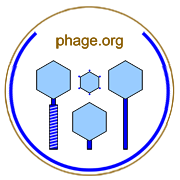

Abstract: [no abstract]
From pp. 6-9: "Phage Therapy and Prophylaxis
"From the very start, d'Hérelle left no doubt as to what he believed to be the nature of the bacteriophage: a particulate, invisible, filtrable, self-reproducing virus that is an obligate parasite of bacteria. But philosophical considerations of the true nature of bacteriophages, however cosmic its importance, paled in comparison with what d'Hérelle conceived to be its immense practical significance. This was spelled out in more detail in his second note (274), published in 1918 and entitled 'On the role of the filtrable bacteriophage in bacillary dysentery.' In it he concluded from the case histories of 34 bacillary dysentery patients that 'the course of the illness is a result of the interaction of the Shiga bacillus and the bacteriophage, the disease and its aggravation corresponding to a deficiency of bacteriophage activity and the amelioration and convalescence to a restitution of the latter. Pathogenesis and pathology of dysentery are dominated by two opposing factors: the dysentery bacillus as pathogenic agent and the filtrable bacteriophage as agent of immunity.' From this conception of the bacteriophage as the agent responsible first for recovery from and then for immunity to dysentery, it was but a short step to imagine the bacteriophage as a marvelous gift of nature to medicine: it would only be necessary to cultivate in the laboratory large quantities of the antidysentery bacteriophage and hold them in readiness for administration to patients showing the first symptoms of the disease. In fact, since the bacteriophage should be as transmissible from one individual to the next as the Shiga bacillus, the immunity so acquired should be as contagious as the disease itself. Why not, therefore, harness bacteriophages not only for the cure but, even more importantly, also for disease prevention in whole populations endemically afflicted with the pathogenic germs? D'Hérelle at once set to work to generalize his observations and quickly found that in patients recovering from typhoid fever and in chickens afflicted with ! WIKIPEDIA>avian typhosa there also appear bacteriophages capable of destroying the respective pathogenic bacteria.
"There is little doubt that it was the emphasis given by d'Hérelle to the medical potential of bacteriophages that drew immediate and widespread attention to his discovery: the Great Hope of Universal Therapy and Prophylaxis. After an initial period of disbelief and ridicule of the announcement that there exists an invisible parasitic virus of microbes, the host of medical bacteriologists everywhere joined in a crusade to exterminate bacterial diseases by means of the bacteriophage. The first results seemed not at all discouraging: bacteriophages active against the bacteria of many diseases—anthrax, bronchitis, diarrhea, scarlet fever, typhus, cholera, diphtheria, gonorrhea, paratyphus, bubonic plague, osteomyelitis&mdashdid turn up promptly, and from 1920 onward an avalanche of publications on bacteriophage therapy made its way into the medical literature. This previously undreamt-of way of ridding mankind of some of its most dreaded ills did not fail to fire also the popular imagination, an aspect of the medical Zeitgeist of the 1920's preserved in Sinclair Lewis' novel Arrowsmith. Martin Arrowsmith, the hero, is working at a medical research institute in New York where he discovers an "x-principle" capable of serially transmissible lysis of staphylococci. D'Hérelle's first note appears just as Arrowsmith is ready to publish his own findings, and Arrowsmith realizes that his "x-principle" and the bacteriophage are but one and the same thing. After overcoming his disappointment at not being the first to discover bacterial viruses, Arrowsmith sets to work to make phage therapy a practical thing. When bubonic plague breaks out in the West Indies, Arrowsmith heads for the Caribbean to tryout there an anti-plague bacillus bacteriophage. Though this trial costs him the lives of his wife and his closest collaborator, Arrowsmith is unable to adduce convincing proof that his ministrations of phage have had any effect on the course of the epidemic. Once more disappointed, Arrowsmith returns to New York, marries a wealthy widow, and resolves to study henceforth the fundamental nature of the bacteriophage rather than its practical a pplications.
"Though Lewis wrote Arrowsmith as early as 1924, he allowed his hero to reach what subsequent developments showed to be a most sensible decision: in spite of twenty years' intensive work, bacteriophages never became a successful medical tool. To be sure, many physicians managed to convince themselves of the efficacy of bacteriophage therapy, particularly in the control of cholera (482), but such converts remained everywhere in the minority. Nevertheless, as late as World War II, bacteriophages were said to have found employ in the medical services of the German and Japanese armies, and even today the medical use of bacteriophages still persists in some out-of-the-way places. But ever since antibiotics have shown themselves to be far more efficacious in the control of bacterial diseases than the most fervent proponents of bacteriophage therapy had ever dared hope for their panacea, the strange bacteriophage therapy chapter of the history of medicine may now be fairly considered as closed. Just why bacteriophages, so virulent in their antibacterial action in vitro, proved to be so impotent in vivo has never been adequately explained. Possibly the immediate antibody response of the patient against the phage protein upon hypodermic injection, the sensitivity of the phage to inactivation by gastric juices upon oral administration, and the facility with which (as we shall see presently) bacteria acquire immunity or sport resistance against phages, all militated against the success of phage therapy."
Return to Home or see Phage Terms/Glossary. Contact web master.












[full text not included]